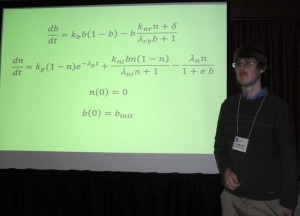Agriculture News
Gatton student presents research at world’s largest mathematics meeting
- Thursday, January 19th, 2012
What began as an independent research project for a student at WKU’s Gatton Academy of Mathematics and Science in Kentucky recently led to a presentation at the largest annual mathematics meeting in the world.

Second-year Gatton Academy student Tennesse “Tucker” Joyce of Harrodsburg presented his mathematical modeling research at the 2012 Joint Mathematics Meeting in Boston on Jan. 6.
Tennesse “Tucker” Joyce, a second-year Gatton Academy student from Harrodsburg, delivered an oral presentation titled Using a Mathematical Model to Analyze the Treatment of a Wound Infection with Oxygen Therapy at the Mathematical Association of America and the American Mathematical Society’s 2012 Joint Mathematics Meeting on Jan. 6. The conference brought nearly 7,200 mathematicians from around the world together for four-days in Boston.
While Joyce has previously presented his research findings at student conferences, the Joint Mathematics Meeting put him on-stage in front of a different kind of audience.
“It was a different experience than previous conferences I’ve been to,” Joyce said. “Though the audience was not much larger, the people watching were experts in my field. I received some great questions and input after the talk, and I got to focus more on the results and significance than I usually do because I did not have to explain the technical mathematics as much.”
Joyce’s research is directed by Dr. Richard Schugart, assistant professor in WKU’s Department of Mathematics and Computer Science. “Tucker is the most gifted student that I have worked with. A professor at another university described his work at the level of a master’s project. I believe Tucker has the potential to be a research mathematician should he choose that as a career path,” Schugart said.
The project uses mathematics to investigate what is an estimated $5 billion to $10 billion problem a year in the medical treatment community. “My research involves analyzing a mathematical model, developed by Dr. Schugart, to describe the interaction of different cell types in a chronic wound. I presented analytic and qualitative results as well as several numerically generated diagrams,” Joyce said.

Gatton Academy student Tennesse "Tucker" Joyce began his research project in September 2010 under Dr. Richard Schugart’s mentorship. In addition, Joyce chose to spend eight weeks of this past summer working full-time on research.
Schugart added: “Ideally, we would like to use the model and the mathematics behind the model to identify the amount of supplemental oxygen needed to eliminate a bacterial infection from a chronic wound.”
WKU faculty such as Dr. Schugart mentor Gatton Academy students in independent, extra-curricular research projects each semester; 85 percent of Gatton Academy students participate in independent research before their graduation from the Academy.
For Joyce, his research experience is helping develop his plans. “Research sounded cool to apply my knowledge to a problem with direct real-world significance,” he said. “My work on this project has shown me that I am interested in applied math, and I have recently been looking into that as a possible major in college and possibly a career.”
About the Gatton Academy: The Gatton Academy offers a residential program for bright, highly motivated Kentucky high school students who have demonstrated interest in pursuing careers in science, technology, engineering and mathematics. Sixty students each year are admitted to the program through a competitive process. Instead of spending their junior and senior years in traditional high schools, students enroll in the Gatton Academy and live in a uniquely dedicated residence hall. The goals of the Gatton Academy are to enable Kentucky’s exceptional young scientists and mathematicians to learn in an environment that offers advanced educational opportunities and to prepare them for leadership roles in Kentucky. At the end of two years, Gatton Academy students will have earned at least 60 college credit hours in addition to completing high school. In 2011, Newsweek magazine ranked the Gatton Academy fifth nationally among all public high schools as part of their annual “America’s Best High Schools” listing.
Contact: Corey Alderdice, (270) 745-2971.
Some of the links on this page may require additional software to view.

